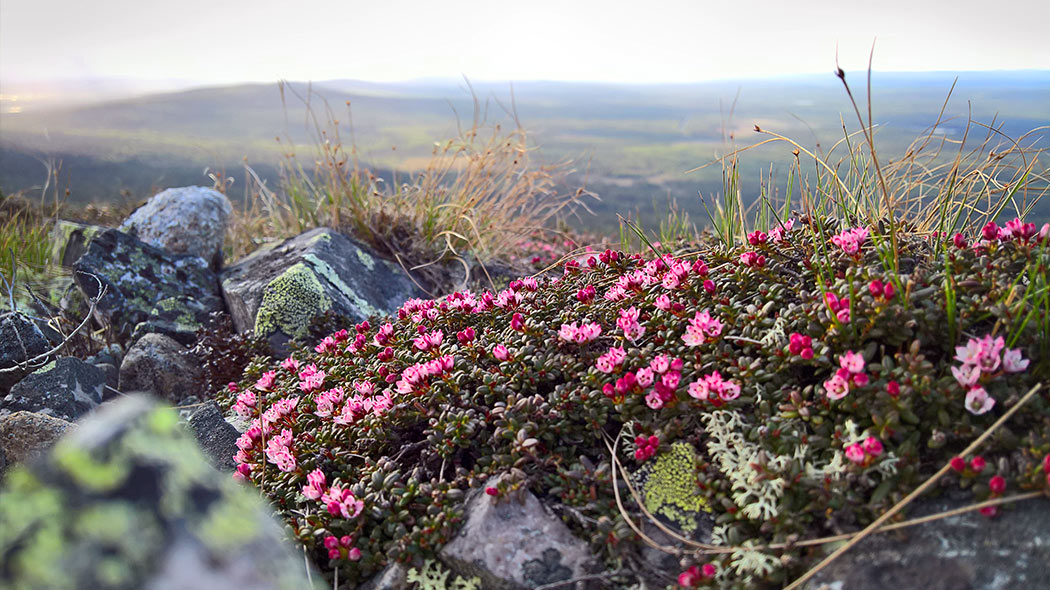Natural Features of Pyhä-Luosto National Park

The tale of Isokuru gorge in Pyhä goes back billions of years

The 35-km-long fell chain in Pyhä-Luosto is a remnant of one of the Earth's oldest mountain ranges. It was formed over 2000 million years ago. The Pyhä-Luosto fells are mostly made-up of quartzite, which in turn was formed from ancient coastal on-shore and underwater sand. This hard rock type has resisted wear, while the mountain ranges other rock types have crumbled away. At some points ripples left behind by ocean waves of old are visible in the rock's surface.

The fells stand-out from the low, level landscape surrounding them. The highest summits are Noitatunturi Fell at 540 metres above sea level and Luosto's scenic Ukko-Luosto Fell at 514 metres. Special features of the National Park are steep slopes, deep ravines, separating fell tops from one another, rugged quartzite quarries and scree patches. The sides of the ravines have been worn away by waters from melting ice. The National Park's deepest ravine is Isokuru, which is 220 metres deep and one of the area's most important sights. Sharp-eyed visitors will notice grooves left by water dripping down the slopes.
Pristine old-growth forests
The timberline in Pyhä-Luosto is at an altitude of 320 to 400 metres above sea level. Because the fell tops are rocky and the bedrock is of quartzite it is quite rugged and there is very little vegetation. The lower slopes of the fells are covered by dense evergreen forests, which change further downhill into vast aapa bogs. Vegetation is quite lush lower on the slopes and in the herb-rich forests on brook banks. The mires in the area are part of the Northern Finland aapa bog zone. There is a diverse array of mire types and there are also lusher mires called fens in the Luosto area. There are many fens especially on the lower course of the River Siurunjoki. The area's many springs also enrich the mires.

Siberian jays in Pyhä-Luosto
One quickly flies up, soon to be followed by another. Siberian jays are curious by nature and tend to keep watch on the branch of a nearby tree to see what hikers are up to.
While the Siberian jay, which favours sheltered old conifer forests, is the smallest bird of the crow family, it moves more like a tit. Hopping from branch to branch, it is always on the move, and its vivacity is only dampened by extremely cold temperatures.

Siberian jays are happy to eat almost anything from berries and seeds to insects, fungi and the eggs and chicks of smaller birds. However, hikers’ picnics can be harmful for them. In the snow-free season, Siberian jays work hard to collect winter supplies, which they stash in cracks in the bark of the trees in their home forests.
While the largest population of Siberian jays is found in the extensive taiga forests of Russia, their range extends to the remote forested areas of Norway in the west. The Siberian jay stays in its territory all year round.
It is a near threatened and protected species.
Wonders of the mires


The southernmost fell plants in Finland
The vegetation of Pyhä-Luosto National Park is typical of Forest Lapland. Fell vegetation such as the Black Bearberry (Arctostaphylos alpina), the Alpine Clubmoss (Diphasiastrum alpinum), the Trailing Azalea (Loiseleuria procumbens), the Blue Heath (Phyllodoce caerulea) add variety. Blueberries (Vaccinum myrtillus) and lingonberries (Vaccinum vitis-idaea) can be found in the area's coniferous forests; where as cloudberries (Rubus chamaemorus) grow in the mires. Along brook banks in other lush growth areas there are more demanding species, such as Wood Crane's-bill (Geranium sylvaticum) and Lady Fern (Athyrium filix-femina). Vegetation indigenous of old-growth forests appear in the Luosto area. There are for example 80 different species of polypores (fungi dependent on deadwood), 11 of which are listed nationally as threatened. Many mosses and lichens appear in the area as well.

Mammals which inhabit the area area permanently are the European Otter (Lutra lutra) and the Brown Bear (Ursus arctos). Moose (Alces alces) dwell on the rims of mires and reindeer search for food higher up on the fell slopes. There have been sightings of 128 bird species in Luosto. A common sight is the Siberian Jay (Perisoreus infaustus) singing on the branch of an old pine. The Rough-legged Buzzard (Buteo lagopus) is a bird of prey, which can often be seen circling fell-tops in search of moles.
Pyhä-Luosto National Park
- Established 2005
- Area 144 km²

The Emblem of Pyhä-Luosto National Park is Siberian Jay and a dead standing tree
Publications of Pyhä-Luosto National Park
Publications of Pyhä-Luosto National Park (julkaisut.metsa.fi)








